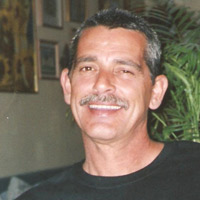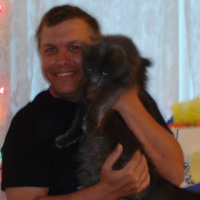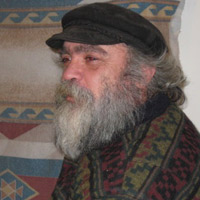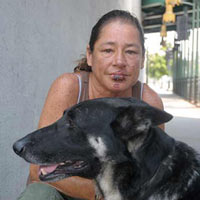Recounting the Lost
A Close Look at the 27 Homeless Who Passed Away in 2009
In the early hours of December 8th, after a heavy rain, Harbor Patrol Officer William Petrini set out on his usual rounds of the waterfront. As he approached State Street on Cabrillo, a homeless man in a wheelchair parked at the foot of Stearns Wharf came into view. With the temperature dipping below 40, Petrini pulled over to see if he was okay. What he discovered was that the man, 58-year-old Paul Bradshaw, or Freedom to street friends, was so cold he couldn’t even speak and his pulse was feeble. Petrini called for an ambulance.
At Cottage Hospital, Bradshaw’s core temperature measured in the high 70s, according to Sergeant Gregg Weitzman of the Sheriff-Coroner’s office. To understand how deadly cold that is, consider that hypothermia is said to occur when a person’s temperature falls below 95 degrees. Bradshaw died within an hour.

It was the 27th and final homeless death in the South County last year, though depending on how you define homelessness, there may have been more. It may not seem like an alarmingly high number but it was a significant jump compared to 2007 (when the number of deaths hovered around 22) and 2008 (when it was roughly 18). No one knows if the spike was a statistical fluke or a sign of some yet-to-be deciphered trend. County funding to community mental health providers was cut last year. Perhaps that was a factor. Perhaps our homeless population is simply aging. In February, the County Board of Supervisors appointed a Homeless Death Review Panel to study the question. A report from them is due in May.
As part of a blog I’m starting on homelessness in Santa Barbara, I decided to look at Sheriff-Coroner reports and other sources for answers of my own. Searches for information on some of the dead came up empty. One individual was identified only by his first name: Shawn. In the end, I found official causes of death for 19 of the 27 people. Three reports, including Freedom’s, are still pending. But even without everyone accounted for, a mosaic of the lost began to come together.
All over the world, homeless people die earlier than people who live in houses. Public health experts settled this question years ago. But a study in the British Medical Journal confirmed it again this past January. One reason is that people enter into homelessness already physically and psychologically vulnerable, in addition to being poor, and the risks just compound from there: lack of medical care, lack of mental health care, exposure to the elements, to violence, to stigma. It adds up fast.
What follows is a sampling of circumstances and stories of Santa Barbara’s lost destitute of 2009. If we look closely, perhaps they hold clues into how our systems and services are failing our most vulnerable residents and how we might prevent others from dying so needlessly.

Of the 19, five died from overdoses. One died from a severe blow to the head, which police suspect was homicide. Eight perished in preventable accidents, including a couple who died of carbon monoxide poisoning when they brought their portable generator onto their bus on a cold night. The remaining five deaths were from physical illnesses.
About half of the 27 lost last year had an addiction. Some took prescription pain meds, others street drugs, some drank, a few did all three. Just over half of this subset had a mental illness in addition. One of them was 43-year old Jeremy G. A relative of his did not want his last name published but did say Jeremy had a longstanding self-esteem problem: He had barely any. An accident on a construction job in his 20s introduced prescription painkillers into his life and he never kicked them. He lived with his sister for a while, but his drug use made it impossible for him to remain. He moved to Casa Esperanza and there he tried and failed to get clean for over two years. In the last months of Jeremy’s life, friends and family said he became progressively more depressed. He was receiving care from county the Alcohol Drug and Mental Health Services Department and taking anti-anxiety meds as well as benzodiazepines. According to many, the day before he died, February 16th, he bought a prescription Fentanyl patch on the street, which is sustained released and far more powerful than morphine. Jeremy died in bed the next afternoon. The coroner’s report lists his cause of death as “multiple drug ingestion.”
A woman staying at the Salvation Army, whom I will call Carol, was, on the surface at least, beating the odds. She was a recent graduate of Bethel House and had a full time job at Long’s Drugs. She was hoping to move into the Hotel Riviera. But when her father died, grief ambushed all her plans. Tragedy compounded grief when a physical problem gave her access to a prescription pain medication. She swallowed a lethal dose on the night of August 15 and left a note.

Steven Levios was well known around town as Steel Guitar Man because he played an impressive mix of bluegrass and classical outside Andersen’s Bakery. Levios wasn’t an addict, but probably did have a mild to moderate form of mental illness, according to his sister Michelle. Perhaps it was the trauma of his parents’ suicides, within three months of each other when he was 13, or all the time he spent alone after his divorce, on his boat and in his camper—which he ultimately lost. Michelle recalled him calling her in 2007. Crying, he said he was tired of living under the bushes and wanted to come home. And he did soon travel to Oregon, living with his brother for six months. But he came back to Santa Barbara after that, resuming his former lifestyle. On August 12, a passerby found him on the 200 block of State Street. He’d had a heart attack.
No one even noticed Camouflage Man was missing. Caltrans workers found him while clearing brush near the Patterson Avenue onramp and according to Sheriff’s spokesperson Drew Sugars, he’d been dead for eight months. His real name was, ironically, John Patterson, and was 62. His nickname came from his always wearing camouflage. Sugars said he was mentally ill, but benign and compliant whenever deputies confronted him. The coroner is still investigating his cause of death.
The homeless who hang out at Pershing Park are still grieving Damon Lawson’s death. His friend Gator described him as a “cool cat” with a “great spirit.” Those who knew him well said he was devastated over the loss of his brother five years ago. Afterwards, he took off from his hometown in Texas, wandering, ultimately landing here. He volunteered at the bait dock during the day and was making plans to go home. But in the meantime, he started having seizures, presumably alcohol-related. He’d had quite a few in a short time span a few months before he died, a friend said. On June 11, he was found on the jetty at the harbor, unconscious, his head bleeding. He died shortly thereafter.

Christhea Puglia, 48, who lived in an RV with her German shepherd, was in jail when she fell on a set of concrete steps during a seizure, presumably from alcohol withdraw. Hitting her head hard, she was rushed to the hospital where surgeons were unable to save her.
Ross Stiles also died of a head injury. He was hit over the head with something. Many say it was a bottle and that he died trying to keep someone from walking off with his sleeping bag.
Dennis Winter, 55, and Joseph Baltzell, 56, were both hit by trains: Winter on September 3, Baltzell on September 4. Baltzell had apparently lain down between the tracks, but as the train approached, got up to avoid being hit.
The coroner’s report says Allan McKibben died of chronic alcohol abuse. But given the strange wounds on his chest, not everyone is convinced there wasn’t more to it. He was wheelchair-bound while his prosthetic leg was being repaired. He was found lying in the bushes not breathing, outside his chair, near the train station. CPR brought his breath back, but brain activity never returned.
Mitch M., 54, was a Vietnam vet and abstract artist. He had bad arthritis, COPD (chronic obstructive pulmonary disease), hepatitis C, and was an alcoholic. He was living at Casa Esperanza and died of an overdose last May 28. A toxicology report found four different benzodiazepines in his blood, as well a methadone. One Casa Esperanza staff member described him as “sweet, gentle, and funny.”
Robert Culp, another vet, contracted an infection which ultimately spread to his blood. He died of sepsis at a Veteran’s hospital down south.
Then there was 55-year-old Tom Palacios, a native Santa Barbaran who had been homeless for only a little over a year, his sister said. He probably had a heart attack, while staying at a motel last September. The coroner’s report on his death is still incomplete. Alcohol and drug abuse kept his life in a perpetual state of topsy-turvy, both before and after he became homeless. After an initial arrest for heroin use in his 20s, he was in and out of jail and prison for more or less the next 30 years, his sister said. But he still managed to become an accomplished artist, specializing in drawings of American Indians. A handful of his works are on display at the American Indian Health Clinic.
Easy Payne and Juanita Robinson were accidentally poisoned when they brought a generator onto their bus for the night.
Joseph Perez was an Italian immigrant with chronic diabetes. Staying at Casa Esperanza while working to get his papers, he lost a leg. Social workers taught him to walk on a prosthetic but he never became comfortable enough with it to abandon his wheelchair. Eventually the diabetes progressed and he died of renal failure in Cottage Hospital.
John Eardly, 71, was in jail when he choked on his food. His family was too upset to talk to me.
What more could have been done in these cases? Perhaps nothing. Perhaps a lot. One thing would be to make mental health services as available as possible. When known alcoholics are booked into jail maybe they could be given anti-seizure meds. Perhaps some mechanism could keep the homeless from selling their medications to each other. Maybe we need more outreach workers whose job it is to simply build relationships with our homeless, to know when they’re experiencing periods of vulnerability.
Freedom’s death spurred community activists to start a system of emergency warming centers for the homeless who, for one reason or another, will never go to a traditional shelter no matter what the weather. On nights when low-temperatures or rain was forecast, area homeless showed up at churches like First United Methodist and the Unitarian Society in numbers ranging from 30 to 40, rolled out their sleeping bags alongside community volunteers, and left at seven the next morning after a cup of coffee. Maybe the centers had something to do with the fact that no other homeless person died from hypothermia last winter. Or maybe it was just a coincidence.



